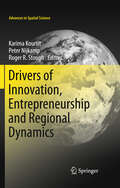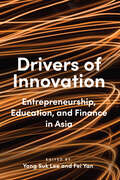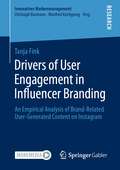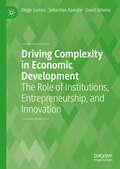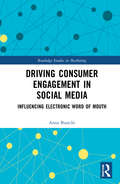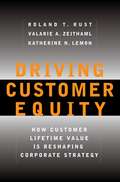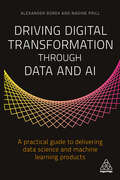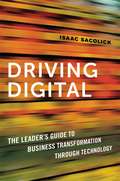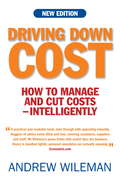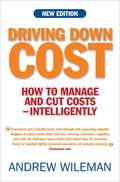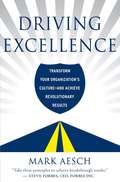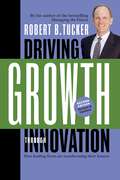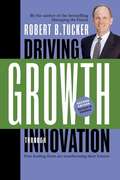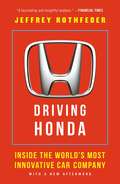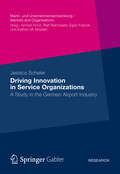- Table View
- List View
Drivers of Innovation, Entrepreneurship and Regional Dynamics
by Roger R. Stough Peter Nijkamp Karima KourtitThe need for informed and effective insights into key concepts and models of regional development and growth, from an endogenous growth perspective, has risen over the past decade. These recent advances address in particular local and regional assets and characteristics comprising inter alia creativity, knowledge, innovation forces and entrepreneurship. Access to and exploitation of these modern forms of human and social capital are of paramount importance for the dynamic regional economic environment in a city or region. This volume offers an overview and critical treatment of the spatial-economic roots, opportunities and impacts of new growth strategies, mainly from an evidence-based perspective. In the various contributions to this volume, relevant findings and strategic options are interpreted and discussed from both an analytical and a policy perspective to help cultivate creativity, human capital development and innovation as well as entrepreneurial activity, with a view to exploit the drivers of economic development, in order to strengthen the competitive edge of cities and regions.
Drivers of Innovation: Entrepreneurship, Education, and Finance in Asia
by Yong Suk Lee and Fei YanInnovation and entrepreneurship rank highly on the strategic agenda of most countries today. As global economic competition intensifies, many national policymakers now recognize the central importance of entrepreneurship education and the building of financial institutions to promote long-term innovation, entrepreneurship, and economic growth. Drivers of Innovation brings together scholars from the United States and Asia to explore those education and finance policies that might be conducive to accelerating innovation and developing a more entrepreneurial workforce in East Asia. Some of the questions covered include: How do universities in China and Singapore experiment with new types of learning in their quest to promote innovation and entrepreneurship? Is there a need to transform the traditional university into an "entrepreneurial university"? What are the recent developments in and outstanding challenges to financing innovation in China and Japan? What is the government's role in promoting innovative entrepreneurship under the shadow of big business in South Korea? What can we learn about the capacity of services to drive innovation-led growth in India? Drivers of Innovation will serve as a valuable reference for scholars and policymakers working to develop human capital for innovation in Asia.
Drivers of User Engagement in Influencer Branding: An Empirical Analysis of Brand-Related User-Generated Content on Instagram (Innovatives Markenmanagement)
by Tanja FinkThe knowledge on how to influence user engagement metrics and thereby brand visibility plays a crucial role in influencer branding – both for social media influencers as well as marketers. Based upon two holistic empirical models and the analysis of real-world data, Tanja Fink is able to show important drivers of user engagement in influencer branding. Therefore, the author is building upon established models from research in celebrity endorsement, product placement and social media marketing. The profound empirical results reveal surprising and highly relevant insights for brand managers which call for a more conscientious (visual) integration of brands in user-generated content (UGC) on Instagram. In addition, the author detects several mechanisms for increasing user engagement while preventing user reactance towards the brand endorsement.
Drivers of Value Capture
by Eric J. Van Den SteenThis note introduces a framework for analyzing value capture (through bargaining and pricing) and bargaining advantage (or value capture advantage), i.e., a firm's (superior) ability to capture a share from the value it helps create.
Drivers of Value Creation
by Eric J. Van Den SteenThis note introduces a concise but comprehensive framework for analyzing value creation and value creation advantage, i.e., a firm's superior ability to increase the spread (or gap) between its offering's customer value (or WTP) and supplier cost (or WTS). (While the framework applies more broadly, it was developed as a component of the PVA framework.)
Driving Complexity in Economic Development: The Role of Institutions, Entrepreneurship, and Innovation
by David Urbano Sebastian Aparicio Diego GomezThis book analyzes the role of institutions in conditioning entrepreneurship and innovation to achieve economic development.Set against the backdrop of populism, this book is based on the premise that formal and informal institutional factors and entrepreneurship are closely linked and that studying the economic development of both developed and emerging economies can help us disentangle the role of entrepreneurship and innovation in developing countries.Using institutional economics as a main theoretical framework and the sociotechnical subsystems as a complementary approach, the authors present a detailed literature review to demonstrate that it is possible to identify the true role of entrepreneurship and innovation in the economic development process. The book embraces complexity to better measure and comprehend economic development, bringing a more compelling perspective on the importance of entrepreneurship and innovation for different dimensions of development.A valuable resource for students, scholars, and policymakers, the authors offer clear recommendations for developing countries.
Driving Consumer Engagement in Social Media: Influencing Electronic Word of Mouth (Routledge Studies in Marketing)
by Anna BianchiSummarizing the extant research on marketing communications, social media and word of mouth, this book clarifies terms often incorrectly and interchangeably used by scholars and marketers and provides principles of effective marketing communications in social media for different brand types and in different geographic markets. Conversations among consumers on social media now have an unprecedented ability to shape attitudes toward people, products, services, brands and to influence buying decisions. Consequently, the digital era brings to the fore the importance of interpersonal relations and the power of personal recommendations. This book is the first to empirically investigate how the form and appeal of marketing communications in social networks influence electronic word of mouth, including an examination of brand type and geographic market. The author focuses on motivations and reveals why people exchange opinions about brands, products and services in the digital environment. The book summarizes the existing research on marketing communications, social media and word of mouth, provides a cutting-edge knowledge based on the analysis of the actual behavior of consumers and rules of effective marketing communications in social media. This research-based book is written for scholars and researchers within the fields of marketing and communication. It may also be of interest to a wider audience interested in understanding how to use social media to influence electronic word of mouth.
Driving Corporate Growth with the Right Disciplines: A Discovery-Driven Approach
by Ian C. Macmillan Rita Gunther McgrathDespite its centrality, driving corporate growth is paradoxical--everyone recognizes its importance, yet it is easy to get it wrong. The result is that every day, anxious executives in well-established companies worry deeply about how they are going to lead strategic growth in their organizations. The time-tested, comfortable approaches to everyday management don't work well in rapidly changing, uncertain environments. This chapter outlines a new approach--discovery-driven growth--and demonstrates how it allows you to harness the essential discovery process required in high-uncertainty situations so that you can benefit from it. This chapter is excerpted from "Discovery-Driven Growth: A Breakthrough Process to Reduce Risk and Seize Opportunity."
Driving Customer Equity
by Valarie A. Zeithaml Roland T Rust Katherine N LemonIn their efforts to become more customer-focused, companies everywhere find themselves entangled in outmoded systems, metrics, and strategies rooted in their product-centered view of the world. Now, to ease this shift to a customer focus, marketing strategy experts Roland T. Rust, Valarie A. Zeithaml, and Katherine N. Lemon have created a dynamic new model they call "Customer Equity," a strategic framework designed to maximize every firm's most important asset, the total lifetime value of its customer base. The authors' Customer Equity Framework yields powerful insights that will help any business increase the value of its customer base. Rust, Zeithaml, and Lemon introduce the three drivers of customer equity -- Value Equity, Brand Equity, and Retention Equity -- and explain in clear, nontechnical language how managers can base their strategies on one or a combination of these drivers. The authors demonstrate in this breakthrough book how managers can build and employ competitive metrics that reveal their company's Customer Equity relative to their competitors. Based on these metrics, they show how managers can determine which drivers are most important in their industry, how they can make efficient strategic trade-offs between expenditures on these drivers, and how to project a financial return from these expenditures. The final section devotes two chapters to the Customer Pyramid, an approach that segments customers based on their long-term profitability, and an especially important chapter examines the Internet as the ultimate Customer Equity tool. Here the authors show how companies such as Intuit.com, Schwab.com, and Priceline.com have used more than one or all three drivers to increase Customer Equity. In this age of one-to-one marketing, understanding how to drive Customer Equity is central to the success of any firm. In particular, Driving Customer Equity will be essential reading for any marketing manager and, for that matter, any manager concerned with growing the value of the firm's customer base.
Driving Digital Transformation in Developing Nations: Case Studies
by Nagy K. HannaThis book provides detailed insight into what governments and institutions can do to drive digital transformation in a nation pursuing economic development. Drawing on real-world case studies and practical advice, the book breaks down digital transformation of public services, healthcare, and the move toward smart cities. Synthesizing publicly available information, the book captures how the World Bank transformed its response to the digital revolution in several nations. Nagy K. Hanna takes readers through the pioneering export strategy of software services in India’s and Sri Lanka’s first integrated digital transformation program. The resulting book is a guide for policymakers, development economists, and change-makers seeking new ways to harness the power of digital technologies to promote inclusive and sustainable development.
Driving Digital Transformation through Data and AI: A Practical Guide to Delivering Data Science and Machine Learning Products
by Alexander Borek Nadine PrillLeading tech companies such as Netflix, Amazon and Uber use data science and machine learning at scale in their core business processes, whereas most traditional companies struggle to expand their machine learning projects beyond a small pilot scope. This book enables organizations to truly embrace the benefits of digital transformation by anchoring data and AI products at the core of their business. It provides executives with the essential tools and concepts to establish a data and AI portfolio strategy as well as the organizational setup and agile processes that are required to deliver machine learning products at scale. Key consideration is given to advancing the data architecture and governance, balancing stakeholder needs and breaking organizational silos through new ways of working. Each chapter includes templates, common pitfalls and global case studies covering industries such as insurance, fashion, consumer goods, finance, manufacturing and automotive. Covering a holistic perspective on strategy, technology, product and company culture, Driving Digital Transformation through Data and AI guides the organizational transformation required to get ahead in the age of AI.
Driving Digital: The Leader's Guide to Business Transformation Through Technology
by Isaac SacolickEvery organization makes plans for updating products, technologies, and business processes. But that&’s not enough anymore for the twenty-first-century company. The race is now on for everyone to become a digital enterprise. For those individuals who have been charged with leading their company&’s technology-driven change, the pressure is intense while the correct path forward unclear. Help has arrived! In Driving Digital, author Isaac Sacolick shares the lessons he&’s learned over the years as he has successfully spearheaded multiple transformations and helped shape digital-business best practices. Readers no longer have to blindly trek through the mine field of their company&’s digital transformation. In this thoroughly researched one-stop manual, learn how to: • Formulate a digital strategy • Transform business and IT practices • Align development and operations • Drive culture change • Bolster digital talent • Capture and track ROI • Develop innovative digital practices • Pilot emerging technologies • And more! Your company cannot avoid the digital disruption heading its way. The choice is yours: Will this mean the beginning of the end for your business, or will your digital practices be what catapults you into next-level success?
Driving Down Cost
by Andrew WilemanWith over twenty-five years of experience in consulting, plus the knowledge of having run over fifty cost-reduction projects internationally, author Andrew Wileman offers a management toolkit for analyzing cost. This in-depth look at how to reduce cost offers tips and tricks and the sneaky, smart ways to turn cost into revenue.
Driving Down Cost: How to Manage and Cut Cost - Intelligently
by Andrew WilemanDrawing on over 25 years consultancy experience running over 50 big one-time, cost-reduction projects internationally, Wileman provides a Cost Management Toolkit of key ideas and cost management strategies for analysing cost-management including procurement and management accounts and looks at how the leadership team needs to take the lead and set the tone on cost. He lays out a set of ideas, approaches, tips and tricks that have worked for him and looks at the sneaky ways cost can be created and the even sneakier, smart ways they can be cut - like getting your customers to do your work for you, or turning cost into revenue. Packed with real-life, international case studies and practical techniques for implementing cost reduction programmes in a period of chaos in the markets and worldwide recession, this new edition could not be more timely.
Driving Down Cost: How to Manage and Cut Cost - Intelligently
by Andrew WilemanDrawing on over 25 years consultancy experience running over 50 big one-time, cost-reduction projects internationally, Wileman provides a Cost Management Toolkit of key ideas and cost management strategies for analysing cost-management including procurement and management accounts and looks at how the leadership team needs to take the lead and set the tone on cost. He lays out a set of ideas, approaches, tips and tricks that have worked for him and looks at the sneaky ways cost can be created and the even sneakier, smart ways they can be cut - like getting your customers to do your work for you, or turning cost into revenue. Packed with real-life, international case studies and practical techniques for implementing cost reduction programmes in a period of chaos in the markets and worldwide recession, this new edition could not be more timely.
Driving Entrepreneurship in Southeast Asia (Routledge Studies in Entrepreneurship)
by Vanessa RattenSoutheast Asia is one of the most dynamic and entrepreneurial regions in the world. Despite its entrepreneurial nature, the study of entrepreneurship has largely been on North America and Europe. This book showcases the entrepreneurial capabilities that are taking place in Southeast Asia from a digital innovation perspective. The book questions the role of entrepreneurship in the Southeast Asian context. It also provides a historical analysis of how entrepreneurship is influenced by the history of individual Southeast Asian countries. It goes on to examine heritage tourism to explore how entrepreneurship is embedded in cultural and social endeavours, and explores how digital technologies and innovations are leading change in the region’s business ecosystems. The book closes by examining the effects of the pandemic from a risk management perspective to show the interrelationship between crisis management and innovation, before highlighting areas for future research. The comprehensive coverage of different countries within Southeast Asia regarding their entrepreneurial initiatives will enrich the existing literature and will be a useful reference to scholars researching entrepreneurship.
Driving Excellence: Transform Your Organization's Culture -- And Achieve Revolutionary Results
by Mark AeschDriving Excellence tells the inspiring story of one man who, with no formal business training, turned an entire industry on its head. Mark Aesch proves that we really can run government like a business, and provide value to taxpayers and shareholders alike.When Aesch took over the Rochester Genesee Regional Transportation Authority in 2004, it was operating with a 27.7-million-dollar deficit, and was poised to raise fares, lay off employees, and slash service. Under Aesch's leadership, those deficits have been eradicated and replaced with multimillion-dollar surpluses; reliance on taxpayer subsidies has been reduced; demand for service has increased at rates three times the national average; and in an unprecedented move, the fare at the Authority's two largest subsidiaries were actually reduced.In Driving Excellence, Aesch shows readers how to create a culture built around selflessness rather than ego, and get employees invested in saving the company. In describing the transition from an ailing business to one that enjoys stunning success--lower fares, multi-million surpluses, and the highest ridership and customer satisfaction levels in twenty years--Aesch offers powerful principles that any organization can implement to achieve exceptional results.
Driving Force: The Global Restructuring Of Technology, Labor, And Investment In The Automobile And Components Industry
by Kurt HoffmanThis book is concerned with the future direction of the international division of labour in manufacturing. It explores the different patterns of foreign direct investment in the eras of machinofacture and systemofacture with respect to a study of the global production of automobile components.
Driving Growth Through Innovation: How Leading Firms Are Transforming Their Futures
by Robert B. TuckerYou’ve read creativity books before, but innovation, as bestselling author Robert B. Tucker explains in this groundbreaking book, is much, much more: it is bringing new ideas to life—to drive growth, profitiablity and competitive advantage. Innovation is fast becoming the critical business skill of the 21st century. Driving Growth Through Innovation will take you behind the scenes to learn the winning methods behind some of the most exciting breakthroughs of our time. You will find out how innovators at Colgate-Palmolive brainstormed a product—Colgate Total—that unseated Crest to become the world’s leading toothpaste brand. Learn how Citigroup, the world’s largest financial services company, has used its global innovation initiative to generate fifteen to twenty percent of their revenue from products that have been introduced in the previous two years. Witness a highly unconventional, even controversial, focus group that Daimler Chrysler used to design the breakthrough PT Cruiser. Get the true story of how developers at Maytag used their experiences with designing the revolutionary Neptune washer to jumpstart growth in a mature market. And how Dana Corporation consistently elicits two ideas per month per employee with a stunning eighty percent implementation rate. This second edition has been revised and updated throughout and includes a self-assessment instrument so that readers can evaluate the innovation culture and practices of their organizations, as well as a discussion of the newly emerging position of chief innovation officer.
Driving Growth Through Innovation: How Leading Firms are Transforming Their Futures
by Robert B. TuckerIn this book, Robert B. Tucker provides a practical method any business can use to identify opportunities and encourage innovations that capitalize on them.
Driving Honda
by Jeffrey RothfederFor decades there have been two iconic Japanese auto companies. One has been endlessly studied and written about. The other has been generally underappreciated and misunderstood. Until now. Since its birth as a motorcycle company in 1949, Honda has steadily grown into the world's fifth largest automaker and top engine manufacturer, as well as one of the most beloved, most profitable, and most consistently innovative multinational corporations. What drives the company that keeps creating and improving award-winning and bestselling models like the Civic, Accord, Odyssey, CR-V, and Pilot? According to Jeffrey Rothfeder, what truly distinguishes Honda from its competitors, especially archrival Toyota, is a deep commitment to a set of unorthodox management tenets. The Honda Way, as insiders call it, is notable for decentralization over corporate control, simplicity over complexity, experimentation over Six Sigma-driven efficiency, and unyielding cynicism toward the status quo and whatever is assumed to be the truth. Honda believes in freely borrowing from the past as a bridge to "innovative discontinuity" in the present. And those are just a few of the ideas that the company's colorful founder, Soichiro Honda, embedded in the DNA of his start-up sixty-five years ago. As the first journalist allowed behind Honda's infamously private doors, Rothfeder interviewed dozens of executives, engineers, and frontline employees about its management practices and global strategy. He shows how the company has developed and maintained its unmatched culture of innovation, resilience, and flexibility--and how it exported that culture to other countries that are strikingly different from Japan, establishing locally controlled operations in each region where it lays down roots. For instance, Rothfeder reports on life at a Honda factory in the tiny town of Lincoln, Alabama, and what happened when American workers were trained to follow the Honda Way, as a self-sufficient outpost of the global company. Could they master Honda's three core principles: Embrace Paradox: Honda encourages respectful disagreement and debate between opposing viewpoints, on matters large and small. New ideas often emerge from conflict. Real Place, Real Part, Real Knowledge: Honda teaches people to argue using facts, not assumptions. One must go to the factory floor, the showroom, the parking lot, the driver's seat, or the truck bed--whatever it takes--to get the facts and make a decision that can be supported with data. Respect Individualism: Honda often hires people with unusual backgrounds and independent streaks. It promotes those who question the status quo and who would probably struggle in organizations that focus on rigid rules and systems. Rothfeder shows how the Alabama plant became a new model for manufacturing in America. It can turn out several different types of cars on any given day and up to 300,000 vehicles and engines a year. Its flexible model enables unparalleled responsiveness to market changes and recovery from mistakes. As Soichiro Honda himself liked to say, "Success can be achieved only through repeated failure and introspection. In fact, success represents one percent of your work, which results only from the ninety-nine percent that is called failure."
Driving Honda
by Jeffrey RothfederSince its birth as a motorcycle company in 1949, Honda has steadily grown into one of the world's largest automakers and engine manufacturers, as well as one of the most beloved, most profitable, and most consistently innovative multinational corporations. What drives the company that keeps creating and improving award-winning and bestselling models like the Civic, Accord, Odyssey, CR-V, and Pilot?According to Jeffrey Rothfeder, what truly distinguishes Honda from its competitors, especially archrival Toyota, is a deep commitment to a set of unorthodox management tenets. The Honda Way, as insiders call it, is notable for decentralization over corporate control, simplicity over complexity, experimentation over Six Sigma-driven efficiency, and unyielding cynicism toward the status quo and whatever is assumed to be the truth. Those are just a few of the ideas that the company's colorful founder Soichiro Honda embedded in the DNA of his start-up sixty-five years ago.As the first journalist allowed behind Honda's infamously private doors, Rothfeder interviewed dozens of executives, engineers, and frontline employees about Honda's management practices and global strategy. He shows how the company developed and maintained its unmatched culture of innovation, resilience, and flexibility--and how it exported that culture to other countries that are strikingly different from Japan, establishing locally controlled operations in each region where it lays down roots.From the Trade Paperback edition.nciples:Embrace Paradox: Honda encourages respectful disagreement and debate between opposing viewpoints, on matters large and small. New ideas often emerge from conflict.Real Place, Real Part, Real Knowledge: Honda teaches people to argue using facts, not assumptions. One must go to the factory floor, the showroom, the parking lot, the driver's seat, or the truck bed--whatever it takes--to get the facts and make a decision that can be supported with data.Respect Individualism: Honda often hires people with unusual backgrounds and independent streaks. It promotes those who question the status quo and who would probably struggle in organizations that focus on rigid rules and systems.Rothfeder shows how the Alabama plant became a new model for manufacturing in America. It can turn out several different types of cars on any given day and up to 300,000 vehicles and engines a year. Its flexible model enables unparalleled responsiveness to market changes and recovery from mistakes. As Soichiro Honda himself liked to say, "Success can be achieved only through repeated failure and introspection. In fact, success represents one percent of your work, which results only from the ninety-nine percent that is called failure."
Driving Innovation from Within: A Guide for Internal Entrepreneurs (Columbia Business School Publishing Ser.)
by Kaihan KrippendorffConventional business wisdom tells us that entrepreneurs are society’s main source of innovation. Young founders leave college with a big idea, get to work in a garage, and build something that changes the world. Typical corporate employees, strangled by slow-moving bureaucracy, are blocked from making transformative discoveries.In Driving Innovation from Within, strategist and advisor Kaihan Krippendorff disproves one of today’s biggest business myths to highlight lessons for innovators and leaders. He reveals how many of the modern world’s most impactful creations were invented by passionate employee innovators. If it were left up to go-it-alone entrepreneurs, we would not have mobile phones, personal computers, or e-mail. Distilling more than 150 interviews with internal innovators and leading experts along with insights from the latest research and today’s most successful companies, from Tencent and Amazon to Mastercard and Starbucks, Krippendorff lays out a step-by-step playbook to unlock innovation from the inside. He maps the barriers that frustrate efforts to disrupt from within and provides tools to remove them, detailing how visionary leaders can create islands of freedom inside an organization to activate existing employees’ potential and beat startups at their own game. Driving Innovation from Within is a practical and inspiring guide to leadership from all levels for those who want the fulfillment of changing the world without leaving their job in order to do it.
Driving Innovation in Service Organisations
by Jessica SchelerWith an ever increasing globalization of the economy, rapid technological progress, and intensifying competition, service firms such as airports constantly have to fuel the engine of renewal to keep on prospering. Nevertheless, research is still left with the critical question how service firms can manage their ability to innovate. By applying a resource perspective, Jessica Scheler explores drivers and barriers affecting the ability to innovate in the airport industry. Findings reveal significant categories and deliver valuable findings for academia and managerial practice particularly with regard to leadership issues, organizational structure, and roles of individuals.
Driving Justice, Equity, Diversity, and Inclusion
by Kristina KohlNavigating the volatility, uncertainty, complexity, and ambiguity (VUCA) characterizing the business world in the 21st century requires a new paradigm focused on an integrated bottom line – planet, people, and profit (PPP). Global trends include resource scarcity and growing inequities in income, wealth, education, and healthcare. Stakeholders are demanding that organizations address systemic barriers to promote justice and equity within organizations and across broader social systems. Transformational change requires leadership to analyze internal and external systems through a social and environmental justice lens. Despite a growing focus on justice, equity, diversity, and inclusion, the imbalance of power remains within our institutions, organizations, and social systems. To move the needle, leaders can turn to Driving Justice, Equity, Diversity, and Inclusion, which explains developing a North Star vision and creating a strategy to redesign organizational process and systems, as well as leveraging tools for data-driven decision-making. It presents a framework to build an inclusive organization as well as a model to engage and support senior and middle management beginning the process of capacity building and systemic change. By layering in AI and other technologies to support data-driven decision-making, the book guides leaders in navigating their organization’s journey along the maturity continuum to achieve their North Star vision of becoming a just and equitable organization. The book also helps managers to Assess ecosystems and organizational systems that justice, equity, diversity, and inclusion impact Take a deeper dive into transformational and operational components to gain insights on the deep systemic realignment of the North Star vision Identify and engage with diverse stakeholders to gain perspective and understand issues crucial for transformative change Leverage people-centered design to create a process promoting diversity of voices and to better align outcomes with shared organizational vision Use data to drive decision-making and reduce bias by removing intuition from the decision-making process Leverage the book's frameworks to drive collaborative systemic change Adapt insights highlighted in multiple interviews with DEI practitioners Benefit from lessons learned and best practices featured in the book's case studies This book features a primer, which is a quick reference guide to key terms, concepts, and definitions. It helps to define justice, equity, diversity, inclusion, and other key terms, such as unconscious bias, stereotypes, and microaggressions. It also features a toolkit, which includes checklists to help managers lead organizations to realize their own North Star vision.
